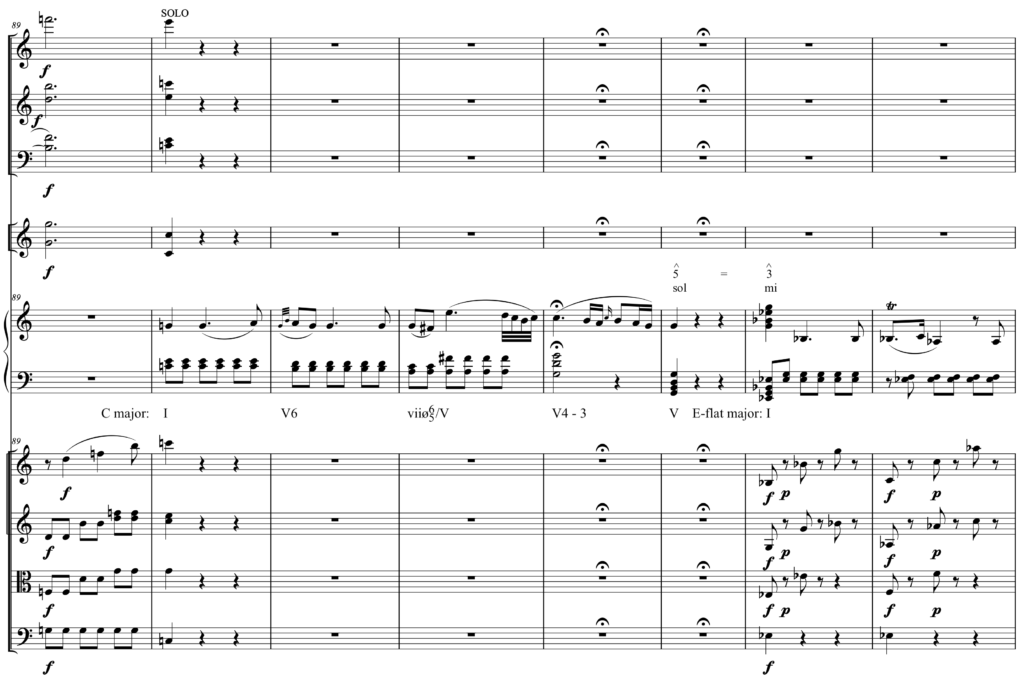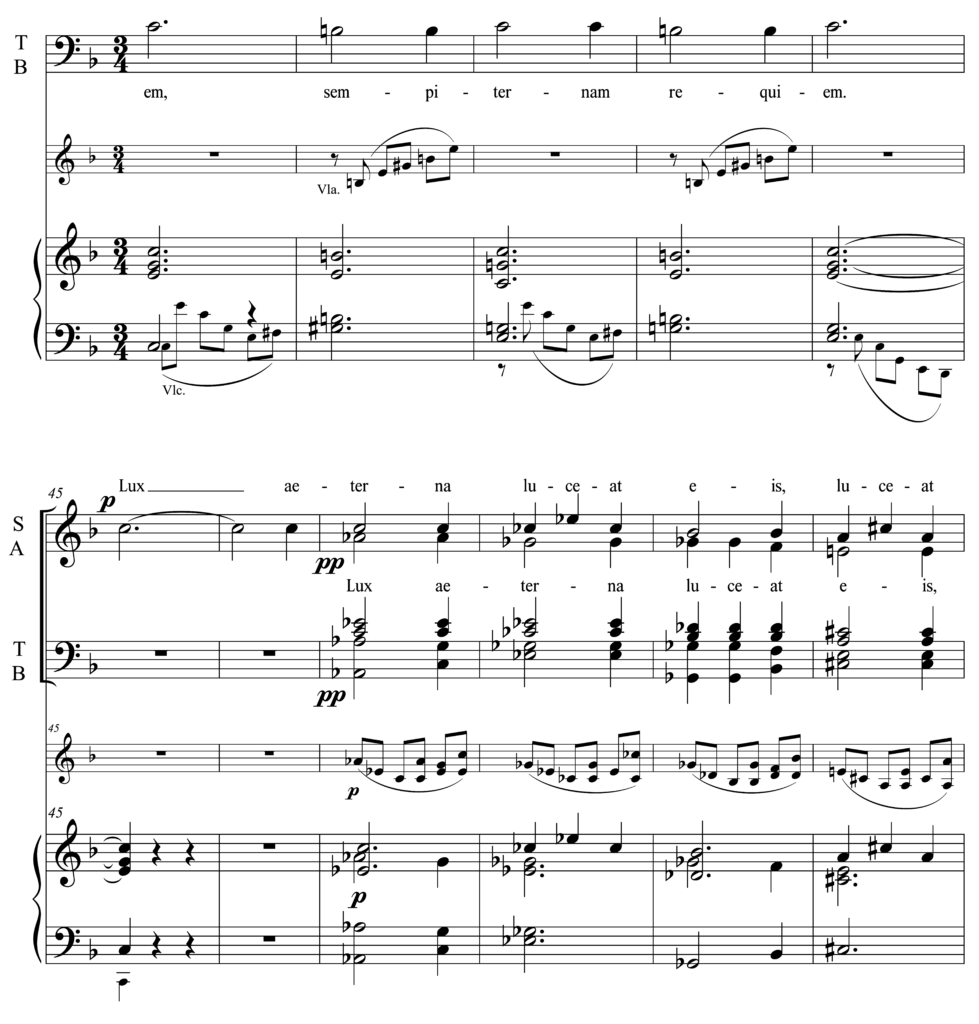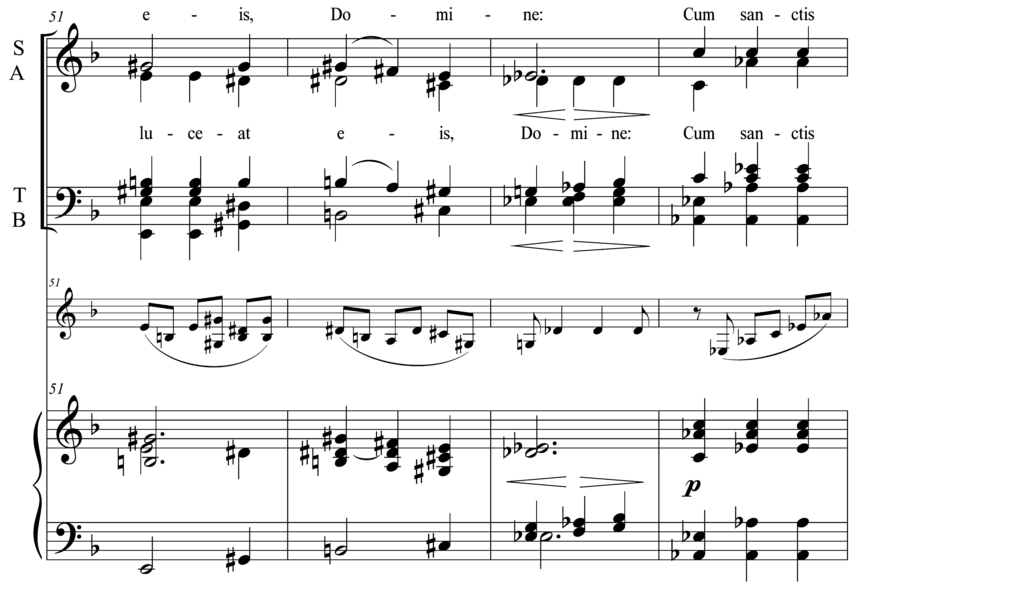Main Body
39 Modulation by common tone
Learning goals for Chapter 39
In this chapter, we will learn:
- How modulations to key areas by common tone work
- How to identify chromatic mediant chords and common-tone modulations in musical contexts
Modulation by common tone
This chapter explores the striking effect that results from modulating from one key to another related by . The common tone between chords related by chromatic mediant may be used as a means for modulation. Example 39‑1 demonstrates this effect in a modulation by common tone from C major to E![]() major (
major (![]() III), using the common tone G to connect the keys to one another.
III), using the common tone G to connect the keys to one another.
Example 39‑1. W. A. Mozart, Piano Concerto no. 17 in G major, K. 453, mvt. 2, mm. 89–96[1]

Listen to the full track, performed by pianist Léonard Hokanson and the Camerata Labacencis, conducted by Kurt Redel, on Spotify.
Learn about Austrian composer Wolfgang Amadeus Mozart (1756–1791) by reading this Oxford Music Online article, written by Cliff Eisen and Stanley Sadie.
Example 39‑2 similarly demonstrates a modulation by common tone from G major to B![]() major (
major (![]() III), using the common tone D to bridge the shift. Listen for bandleader and mandolinist Chris Thile’s beautiful tenor voice, singing the D, to enact the modulation about thirty seconds into the audio example.
III), using the common tone D to bridge the shift. Listen for bandleader and mandolinist Chris Thile’s beautiful tenor voice, singing the D, to enact the modulation about thirty seconds into the audio example.
Example 39‑2. Punch Brothers, “Familiarity,” 6:34–7:35
Example 39-3 features a common tone modulation, moving from the dominant in E major (BMA) to tonic in G major (GMA). The common tone is B.
Example 39-3. Blondie, “Atomic,” 1:15–1:32
Listen to the full track on Spotify.
Learn about 20th-century American rock band Blondie by reading this Oxford Music Online article, written by David Laing.
Video: T72 Modulation by common tone (8:41)
This video presents three examples of modulation to chromatic mediant key areas by common tone. Examples include pieces by Mozart (Example 39-1), Punch Brothers (Example 39-2), and Blondie (Example 39-3).
EXERCISE 39-1 Analysis with chromatic mediants
Listen to and study the following excerpts, and answer the questions for each example.
Questions for Worksheet example 39‑1:
- Assuming the key of C major, what is the best Roman numeral label for each of the following chords?
m. 40: ______
m. 41: ______
m. 42: ______
m. 43: ______
m. 44: ______
- What term(s) best describe(s) the relationship between the chords in mm. 40 and 41?
- What term(s) best describe(s) the relationship between the chords in mm. 42 and 43?
- Why might Fauré have had the sopranos sing the word “Lux” (light) on C in mm. 45–46?
- The section in mm. 47–54 is remarkably chromatic. What term best describes the melodic process used in this passage?
- Assuming the first and final chords in mm. 47–54 determine its overall key (even though the passage is harmonically unstable), what key does this passage start and end in? ____
- What is the relationship between the key implied in mm. 40–45 and the key in the answer to question 6 above?
Worksheet example 39‑1. Gabriel Fauré, Requiem, “Agnus Dei,” mm. 40–54
Listen to the movement, performed by La Chapelle Royale, on Spotify. Access this excerpt by starting the audio just after 2:00.
Read an English translation of the Latin requiem text on the Oxford International Song Festival website.
Learn about French composer Gabriel Fauré (1845–1924) by reading this Oxford Music Online article, written by Jean-Michel Nectoux.
Questions for Worksheet example 39‑2:
- What is the overall key of the opening section (mm. 1–38)? _______
- What is the overall key of the second section (mm. 39–60)? _______
- What term best describes the relationship between the keys in the answers to questions 1 and 2 above?
- In what key does the third section (mm. 61–72) begin? _______
- What term best describes the relationship between the keys in the answers to questions 2 and 4 above?
- What term best describes the relationship between the keys in the answers to questions 1 and 4 above?
- What is the role of the F
 in the melody (piano, right hand) in mm. 38–39?
in the melody (piano, right hand) in mm. 38–39? - Assuming the key of D major, what is the best Roman numeral label for the following chords? (There may be non-chord tones—use your ears and score analysis techniques to choose the best label.)
m. 45, last chord: ______
m. 46, first chord: ______
mm. 51–52: ______
mm. 53–54: ______
Worksheet example 39‑2. Frederic Chopin, Impromptu, op. 36, mm. 1–72
Listen to the piece, performed by Howard Shelley, on Spotify.
Learn about Polish composer Frederic Chopin (1810–1841) by reading this Oxford Music Online article, written by Jim Samson.
EXERCISE 39-2 Modulating dictations
This exercise is to help you learn to aurally identify modulations to chromatic mediants by common tone. For these exercises:
- Play the audio up to four times.
- Your goals are to notate the soprano and bass parts, and to label Roman numerals beneath the staff. You should also indicate the key to which the passage modulates.
- There will always be just four key choices (the mode is always the same). Identify the four chromatic mediant keys to the starting tonic key that have the same mode. In the case of the first dictation below, tonic is F major, so the four areas the dictation could modulate to are D
 major, D major, A
major, D major, A major, and A major.
major, and A major. - The soprano note will be the common tone shared between the tonic triad of the original key and that of the new key.
- Mark the place where you hear the shift occur. Analyze the soprano part and narrow down your choices. In this exercise, we will always connect the first tonic chord to the new tonic chord via common tone in the soprano. For example, if the first dictation progression went to D
 major, the common tone between D
major, the common tone between D major and F major would be F. If it went to D major, the common tone is A; to A
major and F major would be F. If it went to D major, the common tone is A; to A major, the common tone is C; and to A major, the common tone is A.
major, the common tone is C; and to A major, the common tone is A.
The following dictations also appear in Appendix E as nos. 23–25.
MODULATING DICTATION 1
MODULATING DICTATION 2
MODULATING DICTATION 3
Supplemental materials for Chapter 39
Bryn Hughes’s chapter on chromatic modulation (Open Music Theory)
- "Wolfgang Amadeus Mozart (1756-1791) Concierto para Piano No. 17 K. 453 (1784)" by Gory is licensed under CC BY 3.0 ↵
any major or minor triad whose root is related by major or minor third to tonic, and which contains at least one chromatic note; also refers to a key relationship in which the tonics are related by major or minor third and the keys are not closely related




